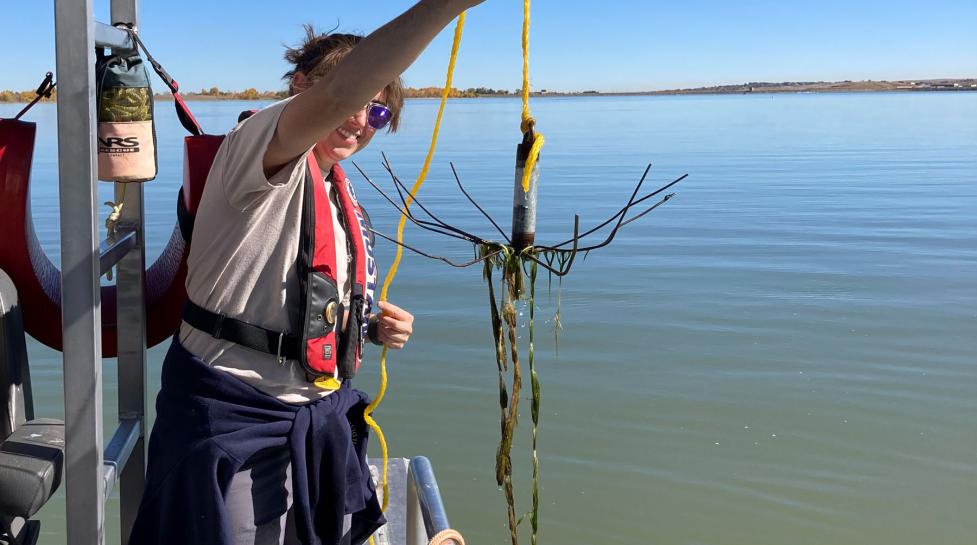This summer, Colorado Parks and Wildlife (CPW) detected the presence of Eurasian watermilfoil (EWM), an invasive plant, in the Boulder Reservoir. During a follow-up survey this fall, CPW confirmed that EWM has become established in the Reservoir.
This summer, Colorado Parks and Wildlife (CPW) detected the presence of Eurasian watermilfoil (EWM), an invasive plant, in the Boulder Reservoir.
During a follow-up survey this fall, CPW confirmed that EWM has become established in the Reservoir. The plant is not harmful to public health and at its current growth levels, there are no impacts to recreation use at the Reservoir or its use as a regional drinking water supply.
EWM is established primarily along the western coves of the Reservoir, as well as in areas along the southern and northern shorelines. The density of EWM is currently low near the swim beach and drinking water intake areas. If it becomes very dense, the plant could impact swimming and boating and cause taste and odor issues with drinking water.
“While the survey confirmed the presence of EWM at the Reservoir, we don’t know how it arrived. It can easily be transported by wind, connected waterways, humans fishing, dogs, watercraft, or wildlife, so we encourage anyone who recreates in the water to be vigilant about checking for aquatic nuisance species,” said Parks and Recreation Director Ali Rhodes. “The survey did find that there are no other aquatic nuisance or invasive plant species in the Reservoir, which is good news.”
The city has one of the most stringent Aquatic Nuisance Species (ANS) prevention programs in Colorado with procedures above and beyond those required by the state, to protect water quality and recreational uses at the Reservoir.
Because the current impact of EWM is low, the city and Northern Colorado Water Conservancy District (Northern Water) are not planning to make any additional changes to water supply operations or recreation activities at the Reservoir beyond changes made this summer. Upon initial detection of the plant, the city adjusted operations to include exit inspections on watercraft, increased education to users and added notification signage.
Eradication of EWM from the Reservoir is unlikely if not impossible since EWM can reproduce and establish from just one fragment.
“We are actively working with CPW, the Colorado Department of Agriculture and Northern Water to monitor EWM growth and assess management options to protect this important water supply and recreation destination,” said Public Works-Utilities Director Joe Taddeucci.
Here are the steps that the city will take to continue to manage the established EWM:
- Continue the existing watercraft inspection and decontamination program, which includes inspecting large watercraft, and small watercraft as allowed, exiting the Reservoir.
- Encourage all visitors to follow a “Clean, Drain, and Dry” practice to confirm that they are not transporting ANS to or from the Reservoir.
- Provide education to visitors about EWM, including those recreating on the North Shore, and targeted communication to anglers and dog guardians.
- Continue the ban on watercraft along the North Shore. Anyone with watercraft or a flotation device in this area and around Coot Lake will be issued a summons with a potential fine.
- Partner with CPW on annual vegetation surveys to assess any changes in EWM.
- Work with the Colorado Department of Agriculture and regional partners with EWM expertise to determine if EWM-eating weevils are present in Boulder Reservoir and would therefore provide natural plant management.
- Conduct a vegetation survey at Coot Lake to determine if EWM is present in that body of water.
- Create a management plan that will provide guidance based on EWM growth and inform EWM mitigation strategies or future adjustments to recreation and water utilities operations.
“Although we are discouraged by the results of the survey, we will continue to work with our partners to protect water quality at the Boulder Reservoir,” said Rhodes.
More information will be posted as available at boulderparks-rec.org and bouldercolorado.gov/locations/boulder-reservoir.
